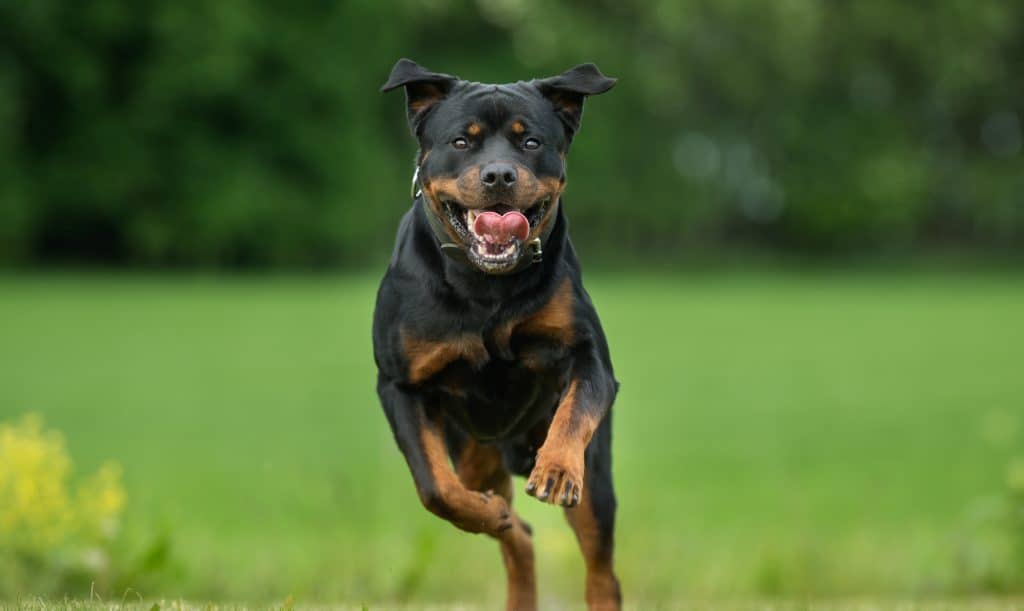Are Rottweilers Easy to Train?

Getting a new Rottweiler is both
So, are Rottweilers easy to train? Rottweilers are known as one of the top 10 most intelligent breeds of dog and, for this reason, Rottweilers tend to be easier to train. Rottweilers will learn commands quicker than many other breeds of dogs. Some aspects of training, such as being a guard dog, may be easier for your Rottweiler to learn than others.
While each breed of dog has a unique history and reason for their breeding, the breeding history of Rottweilers explains many of their habits and temperaments. Curious as to why Rottweilers are easier to train and how to train yours? Continue reading below to find out!
How to Train Your Rottweiler
Rottweilers are one of the easier breeds of dogs to train. To make training your Rottweiler a little easier, I have collected some of my favorite (and most effective) training tips for you to use!
1. Begin at an Early Age
Rottweilers are able to begin learning new commands at any age. However, you should begin training your Rottweiler from an early age if at all possible. By doing so, your Rottweiler will be able to continue to learn new commands later on in life.
Training a Rottweiler puppy should consist primarily of patience, plenty of positive reinforcement, and consistency.
Reprimand your Rottweiler puppy immediately after they do something wrong. Dogs have shorter-term memory than us and waiting too long to correct your puppy will only once again result in fear and confusion.
However, be sure that you never react with anger or malice when training your Rottweiler puppy. Hitting or shouting at your puppy may result in aggressive behavior or might cause the dog to dislike or fear you. You should always emphasize mutual respect and care for each other when you’re training a new puppy.
2. Potty Train Immediately
Having a non-house trained puppy can be both frustrating and stressful. Do not just assume that your puppy will learn from being reprimanded for going to the bathroom in the house.
Start potty training your Rottweiler puppy immediately to help them learn quickly and avoid the stress and frustration! Every dog trainer you speak to will have a different method for potty training puppies. My personal favorite method is the kennel training.
The first night of having your puppy home is full of excitement and snuggles. While you may want to just allow your puppy to immediately begin sleeping at the foot of your bed, you should work on potty training before allowing your puppy to do so.
A few minutes before you go to bed, take your Rottweiler puppy outside until they use the bathroom. Take them back inside and put them in a kennel or carrier for the night. You can nearly guarantee a night full of whining, but do not cave in! This is an important part of the process.
First thing in the morning, be sure to let your puppy out of their kennel or carrier and immediately let them outside to use the bathroom. This method also trains your puppy to not be too active at night!
Another effective method I have used in house training my dogs is having them ring a bell when they need to go outside.You are going to need a rope toy and a medium sized bell for this method. Attach the bell to the rope toy and then attach the rope toy to the door handle of the door you want your dog to go outside through.
When your dog sees the rope toy, chances are they are going to try and play with it. The minute you hear the bell ringing, you need to open the door and put your puppy outside.
Eventually, your Rottweiler puppy will learn that the sound of the bell means that they can go outside to use the bathroom. The best part about this method is that a dog of ANY age can learn this behavior!
3. Use Hand Signals
Do not hesitate to begin teaching your Rottweiler puppy basic commands. Basic command training should be included with their potty training.
Dogs respond very well to verbal commands. However, if your dog doesn’t respond well to verbal commands, or maybe you are looking for a new technique to train your dog, using hand signals might be the perfect method for you!
Hand signals help your Rottweiler to remember commands and to understand what they are being asked to do much quicker than other training methods.
Begin with the command “sit.” A common hand signal for this command is to point straight down at the floor in front of you.
If your puppy does not respond to either the verbal or hand command, hold their collar in one and apply slight pressure down on their rear-end as you say “sit” once more. Once they are sitting, show your Rottweiler puppy the hand signal as you say the command again.
Be sure to congratulate your Rottweiler when they respond to your commands quickly! Rottweilers learn faster when they are given more positive reinforcement.
Need some help thinking of some hand signals for your commands? Well, we got you covered!
| Command | Hand Signal |
| Sit | Pointer finger straight down |
| Lay Down | Flat hand; palm down |
| Stay | Closed fist |
| Go | Point in the direction you want your dog to go |
| Sit “Pretty” | Two fingers together pointed straight down (be sure that your dog is already sitting and that your fingers are just slightly behind your dog’s head) |
An important command for your Rottweiler puppy to understand is to “come.” If your dog begins to run away, they should be trained enough that when they hear “come” they stop and come back to you.
Start teaching this command with a snap of your fingers and treats in your hand. Your puppy will come to know that coming to the sound of a snap will result in benefits. Eventually, reduce the number of treats you give your puppy for coming until they come without needing a treat.
Be careful to remember what hand signal you want to use for each command. Confusing hand signals will make it harder for your Rottweiler puppy to understand what to do.
Just be sure you are consistent in the training with your puppy!
4. Do Not Tolerate Biting

A common habit for puppies of all breeds is biting. However, since Rottweilers have been given a negative reputation, it is extremely important to train your Rottweiler from a young age to not bite.
When you first get your Rottweiler puppy, give them plenty of chew toys. If your puppy bites you or others, be sure to immediately reprimand them and give them a toy to chew on instead.
Each time your puppy bites someone, correct them by saying “no bite” and tapping them on their nose. Be stern with your words and your Rottweiler puppy will realize their mistake and will learn quickly not to bite again.
Teaching your Rottweiler puppy not to bite is not only important for other’s sake, but for your puppy as well! Be consistent with your puppy from a young age to avoid any problems later in life!
5. Socialize Often
Because of a Rottweilers more protective instincts, it is important to train them from an early age to be social with other people and animals.Taking your puppy to meet new dogs and allowing them to interact with new people often will help your Rottweiler to be less territorial and protective of you and your home.
Whether you are inviting guests over to your home or taking your Rottweiler on walks through the park, socialization of any kind is extremely important.
When first introducing your Rottweiler to a new dog, remain calm. They will sense if you are nervous and will be more likely to get into conflict.
Also be watching your dog closely to see how the other dog is reacting. If the other dog begins to grow angry or aggressive with your Rottweiler, remove you and your Rottweiler from the situation.
Always keep a tight grip on the leash and be ready at all times to end any conflict that may arise between your dog and the person they are meeting.
Remember that Rottweilers are not always seen with the same love you have for yours. Many dog owners will not feel comfortable with your Rottweiler approaching their dog, so be sure to keep your dog close by.
If you and your dog are asked to move away from another owner and their dog, be respectful and move on. They may still need some socialization of their own!
6. Continue Teaching Commands!
After your puppy has learned the basic commands, do not end their training there.
Continue teaching your dog new tricks or helpful commands throughout their life. Since Rottweilers become very dedicated to their job, continuing to teach your Rottweiler tricks and commands throughout their life will help them to always feel a sense of accomplishment.
Some fun tricks for you and your Rottweiler to learn are to shake, high-five, bow, speak, roll over, or even to play dead.
Use the same methods as described above to teach these commands and expect your dog
Rottweilers: a Brief History

Rottweilers are thought to be descendants of the Roman Mastiff. This Mastiff was used to herd sheep and cattle across Europe as the Romans conquered new lands. After the fall of the Roman Empire, the Rottweiler breed found its call to duty in the cattle lands of Germany.
The breed’s main objective was to protect cattle from predators and to keep the herd of cattle together. When the cattle were taken to the market, the Rottweilers would then be used to pull the carts filled with the freshly cut meat.
Later in history, the German police forces began to use Rottweilers to chase after criminals. Since the Rottweilers were already bred to be protective of cattle, this job suited the breed extremely well.
Knowing the history and background of the Rottweiler breed can help us to understand why the dogs act the way they do. This even explains why they are often given the stereotype of being “aggressive.”
Sheep dogs and cattle dogs need to be extremely obedient to ensure that none of the herd is lost, injured, or killed. So Rottweilers learned quickly what their owners commands meant, making them one of the easier breeds to train today.
However, because Rottweilers needed to be strong and protective to complete jobs, they were seen as an overly aggressive or violent breed. Rottweilers are extremely loyal and when given a job, they commit to completing their job without any questions.
Rottweiler Intelligence
When judging how intelligent a breed of dog is or how easy they are to train, there are several factors that come into consideration.
The intelligence of a dog is split into three different categories. These three categories are their instinctual intelligence, adaptive intelligence, and work and obedience intelligence.
Instinctive
First, let’s discuss what it means for a dog to have instinctual intelligence. As we discussed above in the brief history of a Rottweiler, we saw that each breed has been trained over the years to complete a unique and specific task.
How well a dog remembers and calls upon the skills needed to complete these originally tasks they were bred for is called their instinctual intelligence.
Rottweilers are known to be extremely protective, loyal, and strong. All of this points to them having a higher instinctual intelligence since each of these traits were needed to fulfill their assigned job.
Adaptive
Second, you need to look at a dog breed’s adaptive intelligence.The adaptive intelligence relates to when a dog is confronted with new problems or obstacles and how well they solve or avoid these problems. Otherwise referred to as your dog’s personality.
This intelligence level does not pertain to the breed of dog but is connected to each individual dog. Since each dog is unique there cannot accurately be a general statement for what a Rottweiler’s adaptive intelligence level would be.
However, many people believe that Rottweilers tend to be lower in this intelligence level and act rather “dumb.” This can be seen in some of a Rottweiler’s crazy, sporadic, and often humorous behaviors.
Work and Obedience
The final aspect of measuring a dog’s intelligence is their work and obedience intelligence level. This simply refers to the breed’s ability to learn, understand, and complete commands given to them by their owner.
Since Rottweilers are very devout to the jobs they are assigned to do, as a breed, Rottweilers tend to have a higher work and obedience intelligence level. This may originate from their history as being cattle dogs and the importance of understanding their owners’ instructions at all times.
In summary, Rottweilers are more likely to have higher levels of instinctive and work and obedience levels; meanwhile, their adaptive intelligence levels can vary drastically by each individual dog.
When tested on their work and obedience intelligence, Rottweilers were ranked as the 9th most intelligent breed (out of the 200 other breeds tested). With that fact in mind, you can rest assured that your Rottweiler will be an easy train!
Content courtesy of Psychology Today.
Related Questions
Are Rottweiler mixes easier to train? Since Rottweilers are one of the easier to train breeds of dogs, their mixed breeds should also be easier to train. However, how easily the dog is to train depends on what the other breed is. For example, Basset Hounds are stubborn and tend to be harder to train, even when mixed with Rottweilers.
Why does my Rottweiler keep leaning against me? Since Rottweilers were bred to herd cattle, the breed gained the instinct to lean against the sheep or cows to get them moving in the correct direction. Rottweilers continue to have this habit from instincts not for many other reasons.
